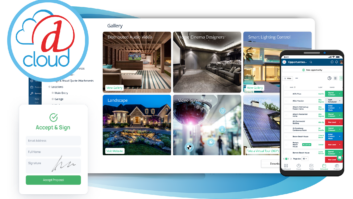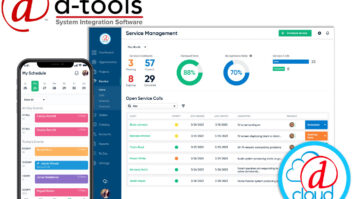It’s hard to imagine how businesses in the olden days survived without the convenience of integrated computer systems to track inventory, customer orders, accounting functions and the various other tasks that companies must complete on a daily basis. At the same time, the selection of the software that does the job is a difficult choice, because the package that you choose to run your business has a direct effect on how the company performs. For custom installation firms, the issue is integrating back-office functions, such as accounting into proposal and project management systems. Home Media Richmond in Midlothian, Virginia, attempts to achieve this through the use of MYOB Account Edge for inventory management, invoicing, purchasing, accounts receivable and accounts payable; and Horizon’s Custom Proposal System for proposal generation. Home Media has also created a custom interface that enables its users to import proposals into the “sales order” module of AccountEdge.
“I don’t know anybody that feels that their accounting system and the integration of it to their proposal and project management system is perfect; everyone is piecing software together as best they can,” said Ray Lepper, president of Home Media Richmond and vice president of CEDIA. “Most of the businesses in the CEDIA channel are single location, and running only one set of books. The fact that our accounting systems tend not to be multi-location, multi-warehouse and multi-user isn’t too big of a problem, but as our companies grow, it becomes a problem.”
However, Lepper pointed out, custom installation firms do use service trucks, and tracking the products that these trucks transport is an issue. “None of the small systems that I’m aware of address inventory management particularly well,” he said. “In real life, we have vans driving around with equipment in them, and we need to know where that inventory is. Because we don’t have software that allows for multiple locations of inventory, we have to develop these cobbled–together systems that track the inventory that is rolling around on the highway. The bigger our companies get, the more value is rolling around on the highway. We would like to have good systems for tracking that.”
The combination of tasks that custom installers perform also makes it difficult to configure a traditional accounting package, according to Lepper. “Some of the charts of accounts that we want to use in our custom businesses don’t lend themselves to our type of business, and you have to make a lot of compromises,” he said. “They either want us to be a retailer or a service provider, and we’re kind of in the middle. For some of the ways we want to track things, we really have to work around the off-the-shelf systems.”
Randy Stearns, president of Engineered Environments in Oakland, California, believes that the custom installation industry is unable to support a single, fully integrated software solution. “The industry is not big enough for a software developer to develop a custom program for it,” he said. “I also believe that the companies in our industry do not have the financial strength to purchase some of the larger programs that are out there, like an SAP type of product that can manage the business. We don’t have hundreds of thousands of dollars to invest in a fully-loaded software product that can run our businesses.”
Nor, Stearns says, is it that big of a deal. Like most companies, Engineered Environments combines the use of several software packages, including Master Builder (Intuit), Microsoft Visio, AutoCAD (Autodesk) and proprietary business management software developed both inside and outside of the company. “[I don’t know] that the industry is truly in need of an integrated solution,” he said. “There has been a lot of talk about it, but I don’t find it that cumbersome not having one. It may be cumbersome for a large organization that has lots of employees, but there are not that many industries that are reliant on a single software package. It’s pretty rare.” Mike Anderson, president of Architronix Inc., in Dallas, Texas, acknowledged that getting results from an accounting package requires custom installation firms to price their services properly. “There are so many different elements that have to be handled by so many different kinds of people–it’s not a traditional ‘sell it-invoice it-collect the money’ business,” he said. “We are basically a building subcontractor that does progressive billing. Tracking job costs is crucial to survival. That is where most people fail; they don’t charge enough for their labor, their project management time, driving time, or systems design time. That is where the smaller companies are getting into trouble and, frankly, in the beginning we were as well. We had to learn that.”
To manage operations in the Dallas office and warehouses in Dallas, Houston and Columbus, Ohio, Architronix utilizes D-Tools for systems design functions, and MAS 90 (Best Software) for daily operations. As a systems integrator, Adam Stone, now president of D-Tools, was constantly writing his own business management software. Stone began doing this during the early ’80s, writing DOS-based software to run his company. After selling his company and going to work for an electrical contracting firm, he began seriously working on the concept for D-Tools.
“Just to avoid the kind of common mistakes where everyone needs to get accurate information on the job, I came up with this process where you put everything that everyone needs into one project file. Then the people who need the information extract it out of the one file,” Stone explained. “As a change is made, it is made all the way through; if a project manager moves an electrical outlet or changes a spec, everything changes all the way down to the cost of the project.” D-Tools is PC-based and sold directly from the developer. It uses Microsoft Visio as its graphic engine. Arguing that a job proposal dictates the results of an entire project, Stone explained D-Tools’ emphasis on proposals. “It’s safe to say that every systems integration project that has ever been done started with a proposal or an estimate – it’s a key component to making it all right,” he said. “The accuracy of that proposal or estimate foreshadows the accuracy of the entire project. Doing an accurate proposal and estimate was key.”
Roland Graham, president of AVD Media, in Chewelah, Washington, admitted that one of the deciding factors in using D-Tools was its relationship with Microsoft. “One of the risks that we run of using a software program as a core piece of our business is that if that software developer disappears, what happens to us?” he said. “If it’s completely dependent upon that software, obviously it was not a wise decision to use that software. Stability is critical, and the tie-on with Microsoft is probably a fairly good thing.”
Also targeting the custom installation market is Stardraw, a New York City-based software development company that has addressed the staging market for close to a decade. Company president Randell Green described the software, “It is a presentation, documentation and design tool that is mainly focused in the following arenas: Stardraw Lighting 2D, which is for laying out lighting plots; and Stardraw Professional, which also has a three-dimensional aspect to it so that you can do any design that you want in 3D. Then we have Stardraw Audio and Stardraw A/V, which are of most interest to custom installers, because it is used for laying out an audio or A/V system.” Based in Pleasanton, California, Axiom Design is currently in the process of transporting its business management software functions from a number of off-the-shelf packages such as Microsoft Office and QuickBooks to a single solution called Project Arena. “Project Arena is a unified system with more robust reporting capabilities and much more flexibility,” said Dana Dornsife, co-founder of Axiom. “By combining functions in one system, Axiom Design can manage the business aspects of many projects more effectively, gaining insight into individual projects or the big picture from the same source. We are already seeing payoff from the effort required up front to get our data moved into the Project Arena system.”
During the early ’90s, Southern California-based systems integration firm AudioVisions developed its own proprietary business management software, which the company marketed under Merlin Software. Merlin released several Macintosh-only packages, including AV Wizard and Proposal Wizard. The company offered these products to the systems integration industry for a couple of years before its founders decided to fold the venture, which was not profitable.
“We were not charging enough money for the software or the tech support,” explained Mark Hoffenberg, president of AudioVisions, who said that the various software packages ranged for $1,000-$2,000. “But, at that time, the amount of money that we were charging for software was probably all the most companies could have afforded.” The exercise did turn out to be profitable for AudioVisions in other ways, however. “We learned a lot about what it takes to run a custom installation company, and we gained a lot of insight from the people that used our software,” Hoffenberg said. “After looking at it long and hard, we decided that the direction in which we really needed to go was to turn our software into a better tool for us. One of the things that we needed to do in order to make that happen–as we continued to expand and hire more employees and considered multiple locations–was to transform it from a single-user product into a true client-server application. We started over and wrote the next generation of the software, starting from the ground up as a client-server cross platform application with TCP/IP capabilities built into it. At that point, its usefulness skyrocketed; it was a true business management tool for our whole company.”
AudioVisions calls this latest rendition of its software ProIntegrator. While custom installation is a niche market, Hoffenberg noted that it’s not that different from many other trades–something that should be considered when configuring a software package. “It’s a relatively small, fragmented industry at this time, and everyone is going about reinventing the wheel right now,” he said. “We saw that a lot when we were selling the software; everyone was doing things differently, and everyone thought that they were doing it the right way. In broad brushstrokes, our business is a contracting business. It’s different than some contracting businesses, because there is a combination of things involved: custom software, wiring, custom solutions that we have to build and off-the-shelf parts that can be purchased at stores.”
However, Hoffenberg noted, the custom installation industry is a little different than your typical contracting business, which usually starts with raw materials and ends up with a finished product. “But there are some comparisons that can be made to the electrical contracting trade, plumbing trade and the general contracting trade,” he pointed out. “It’s not entirely unique, but it is unique enough that off-the-shelf software doesn’t really exist to run a complete systems integration business.”
Carolyn Heinze works from her media services firm in Vancouver, BC.






